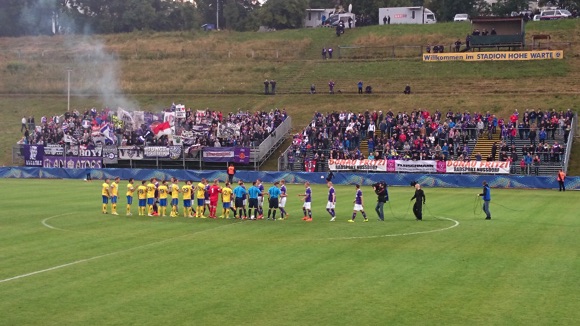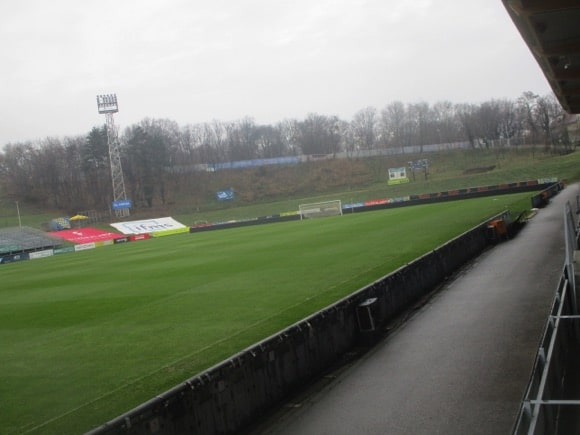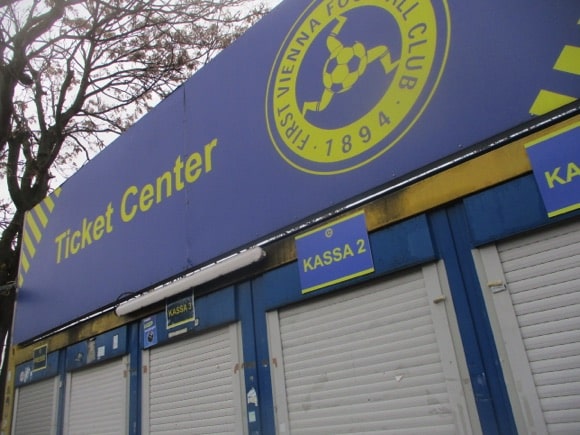A fan’s guide – the club from early doors to today
Austria’s oldest football club, First Vienna have overcome near insolvency and the removal of their professional licence to return to Austria’s second tier.
This allows the club’s solid fan base and the many curious visitors to watch a decent standard of football at the quaint, grass-banked Hohe Warte ground in Heiligenstadt, where Beethoven once lived.
The club was formed by English gardeners on Baron Rothschild’s estate in 1894. That same year, having adopted the Baron’s horse-racing colours of blue and yellow, they took part in the first official football match to be played in Austria, against Vienna Cricket & Football Club.




The club have another British connection: their three-legged badge, designed by Manxman William Beale, a Vienna player of the day. (Local fans refer to the club as ‘Vienna’ in the English way, as opposed to Rapid Wien and Austria Wien, in the local vernacular.)
From 1921, Vienna started playing at Hohe Warte, whose grassy surroundings and nearby hilltop vantage points are quaint even by Viennese standards. Back then, this was Austria’s national stadium until the Prater was opened a decade later.
Perhaps even more remarkably, that was when First Vienna beat the likes of Sindelar’s Austria Vienna and the great Rapid side to the league title, thanks to playmaker ‘Fritz’ Gschweidl and heading specialist ‘Poldi’ Hofmann. They won the Mitropa Cup, a Central European forerunner of the European Cup, that same year, and won the league again in 1933.



Today a stone commemorating Hofmann and later club hero Rudi Röckl stands at the foot of the stadium floodlights, which illuminated the country’s first floodlit match in 1956.
First Vienna notched up three more championships in the war years, plus the German Cup in 1943, but their last major honour was the league title of 1955. Key man was one-club midfielder Karl Koller, who made more than 800 appearances in yellow and blue, in a career that spanned three decades.
Relegated in 1968, First Vienna first bounced back but yo’yo’d between the top and second tiers for many years. Star players came and went, Hans Krankl on a half-season loan from Barcelona, Mario Kempes for a similar length of time in 1986-87.
Still qualifying for Europe – Olympiacos required away goals to beat them in 1989 – First Vienna made the Austrian Cup final in 1997 thanks to a penalty shoot-out over Austria Salzburg. Sturm Graz then had a bit too much big-game experience at the national Ernst-Happel-Stadion.



This was First Vienna’s last 90 minutes in the limelight. Relegation to the third tier in 2001 was a near permanent move, apart from a brief stint in the second flight under Rapid legend Peter Stöger a decade later.
Docked points and having their professional licence revoked in 2012-13, the club filed for bankruptcy in 2017, First Vienna were demoted to the fifth-tier 2. Landesliga and seemed doomed. Not a bit of it. The club marked its 125th anniversary in 2019 by reaching the fourth-flight Wiener Stadtliga, followed by a further promotion in 2021, then another immediately afterwards.
In 2023, First Vienna finished neck-and-neck with FAC Vienna in the 2. Liga, the highest-placed clubs from the capital after Austria and Rapid in the Bundesliga. Hohe Warte welcomed the second-highest gates in the division, nearly 2,000 per home game, many of them dedicated fans who had stuck with the club through the lean times of enforced relegation.
Stadium Guide
The field of dreams – and the story behind it











The 5,500-capacity Hohe Warte harks back to a time when football in Vienna set the European standard. Opened in 1921 before First Vienna’s golden era, this arena of steep grass banks was Austria’s national stadium. Some 85,000 were packed around the pitch for the visit of Italy two years later, although April rain caused part of the bank to subside.
When the Prater opened in 1931, Hohe Warte lost its status, but continued to attract healthy crowds after the war, when it was also occasionally used by homeless Austria Vienna.
Today the banking only provides a romantic backdrop to proceedings, as spectators may only occupy the main stand that was built in 1974. Hiking up the steep footpaths behind the ground may allow a hindered view of the action for free – but you’re as well paying to get in, for a slice of football history.
In the main stand, sector A is for standing spectators, B-C and E for seated.





getting here
Going to the stadium – tips and timings


Take U4 to its terminus at Heiligenstadt. Exit straight out of the station, across enclosed 12.Februar-Platz – you’ll see the floodlights behind over the rooftops.
You’ll still have to turn left along Heiligenstädterstraße, then right up Püchlgasse by the Pezis Café Ecke, up a gentle incline you’ll see ahead of you. The ground is on your right.
getting in
Buying tickets – when, where, how and how much


At the windows just inside the main gates, admission is €14 to stand in Sector A, €16 to sit in Sectors B, C or E. It’s €13 (€11 to stand) for under-19s and €6 across the board 6-14s.
The club also offers online sales, with an English-language option when purchasing.
what to buy
Shirts, kits, merchandise and gifts


An outlet between the entrance and the main stand at the stadium operates on match days for blue-and-yellow merchandise – and otherwise the club has an online shop.
Where to Drink
Pre-match beers for fans and casual visitors









Within Heiligenstadt station, the small smoky S’Weckerl serves Balkan grilled favourites pljeskavica and ćevapčići, alongside equally affordable beer.
On Heiligenstädterstraße towards the stadium, at the corner of Püchlgasse that leads to the stadium, the Pezis Café Ecke caters to its friendly regulars, many of them First Vienna fans. A random collection of decorative retro items dangles over the bar and spreads around the cosy interior, where you’ll spot an old TV and a record player sporting the Freud 45 We Are Vienna. Check out the video – it was filmed in the café.
At the stadium, to the left as you walk through the main gate, FAIRPLAY is attached to the adjoining tennis club, its terrace overlooking the courts. Overseeing this welcoming café/restaurant is Mike, who polished his English while working in hospitality in the UK. Presented with a First Vienna shirt signed by all the players for his 50th birthday here, he added it to the items on display, including lovely photos of the youth team in action. A full menu complements the draught Budvar and Ottakringer on offer.
Under the main stand, kiosks dispense beer and snacks on match days – look out for the ‘Thirst Vienna’ signs – while the VIP Classic marquee behind one goal caters to sponsors and visitors paying top dollar.







